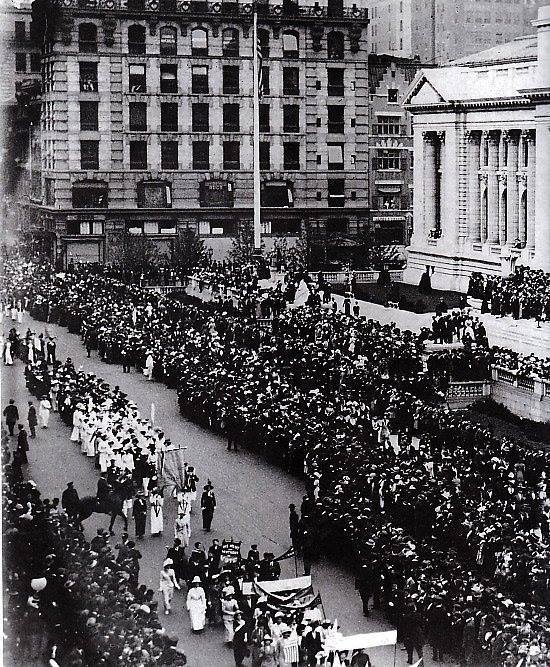
Today in Feminist History is our daily recap of the major milestones and minor advancements that shaped women’s history in the U.S.—from suffrage to Shirley Chisholm and beyond. These posts were written by, and are presented in homage to, our late staff historian and archivist, David Dismore.
May 4, 1912: What a day for our cause!

There has never been a suffrage parade to compare with the one this afternoon, and in the opinion of some, New York City has never seen a spectacle equal to this one on any occasion. Not even the crowds that greeted Teddy Roosevelt’s homecoming two years ago approached the number of spectators on hand today.
But it wasn’t just the size of the crowd or the number of official marchers that was enough to impress some of even the most cynical of suffrage skeptics. Those who represented woman suffrage today clearly did not just casually show up in response to the many leaflets and posters that have been distributed around the city.
Participants were carefully and colorfully outfitted and came to march as part of a specific contingent with which they shared some characteristic. They walked behind elaborate banners emblematic of their group to show just how far pro-suffrage sentiment has penetrated into all segments of society.
There were teachers, students, doctors, lawyers, homemakers, nurses, musicians, industrial workers, clerks, stenographers, and every other imaginable occupation represented. They were led by 52 women riders on horseback and accompanied by numerous marching bands.
The age spectrum was so wide that not all participants could march. Infants were carried, or pushed along in strollers, while carriages transported Reverend Antoinette Brown Blackwell (who’ll turn 87 on the 20th) and a few others among the eldest of the suffragists. Those pioneers could remember being criticized by some who thought it excessively bold for a woman to speak on a political issue to even a small indoor audience. But today these veteran suffragists were a conspicuous part of the 15,000 who took over Fifth Avenue for several hours to promote full and equal suffrage.
There was even a delegation of several hundred men. Some of them had gray hair, some wore silk hats, but many more were college students marching behind banners denoting such prestigious schools as Yale, Harvard, Columbia and Princeton. Despite provocations from some hecklers on the sidewalk, no one in this group lost his dignity or temper.
From the parade’s beginning at the Washington Arch at 5:00 p.m., until the parade ended in torchlight at Carnegie Hall, suffrage supporters owned the street. Even the weather cooperated. It was one of those warm May Saturdays with plenty of late afternoon sunshine and a cool breeze when needed.
Just four years ago, it was considered highly controversial when 23 members of the Progressive Woman Suffrage Union boldly—and illegally—marched along Broadway. Two years ago 400 women, led by Harriot Stanton Blatch of the Equality League of Self-Supporting Women, marched along Fifth Avenue, despite being warned by a number of fellow suffragists that such a spectacle would “set suffrage back 50 years.” But the parade was such a success that it has become an annual event, with the new route used ever since. Last year 3,000 marched, with floats and bands included for the first time.
Impressive as it was, last year’s parade pales in comparison to this year’s, and it seems clear that some new level of respect and recognition has finally been reached by the suffrage movement. Certainly the victory in California on October 10th, in which the Golden State became the sixth to enact equal suffrage and nearly doubled the number of women voters in the country overnight, has played a part in generating new momentum nationwide.
But it is Harriot Stanton Blatch and her renamed Women’s Political Union that deserve most of the credit for putting together this landmark event and enabling such a powerful message to be sent. Marchers gave notice to the State Legislature—whose failure to put a suffrage referendum on the ballot was a primary focus for this year’s march—that “Votes for Women” is an issue that needs to be addressed by the electorate in a Statewide referendum. They also told the journalistic community that woman suffrage advocates are no longer to be ridiculed or ignored, but should be covered in a style befitting a large and growing movement.
One banner, carried by supporters of Wisconsin Republican Senator and Presidential candidate Robert “Fighting Bob” LaFollette, spoke to the “antis” and seemed to sum up the confidence felt by all suffragists today: “Woman Suffrage Has Passed The Stage Of Argument. You Could Not Stop It If You Would, And In A Few Years You Will Be Ashamed You Ever Opposed It.”
But the main message sent today was to those who instinctively feel that woman suffrage is right, but who have not yet acted to bring it about. They were reminded that the denial of the vote to half the population is not simply unjust, but is a waste of ability and wisdom the country can ill afford as it confronts the new challenges of the 20th Century. So now is the time to get on the bandwagon and join the battle to bring women one step closer to full political, economic, and social equality, and to establish a true democracy in America.





